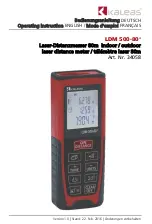
3.6 Other
functions
3-9
Functions
3.3 Output
function
■
Ouptut terminal 1/output terminal 2/output terminal 3 function
setting
PMU1A
(Electric
power)
PMU2A
(Power
two-system)
EMU8A
(Pulse/temperature)
CTD8E
(CT
expansion)
{
{
{
{
O: With setting
• An arbitrary output can be set at each of output terminal 1, output terminal 2, and output
terminal 3. This setting can perform alarm outputs, pulse outputs, 3-STATE outputs, etc.
<When setting an alarm output>
When an alarm output is set, the alarm output can be performed only by setting the alarm for the
output terminal setting with alarm parameter setting/alarm output setting made.
» Alarm parameter setting
This setting is made to judge alarms. Alarms that have been set can be confirmed using the
alarm history, status, and alarm LED.
» Alarm output setting
This setting is made to output alarms. Selecting multiple alarms outputs them when one of them
enters an alarm condition.
For the setting range of alarm parameter setting, alarm output setting, and output terminal setting,
refer to "List of parameters" on Page A-9.
A reverse phase alarm not included in the alarm parameter settings is judged as an alarm by
setting the reverse phase detection to ON.
Alarm parameter setting includes the following items, from which an alarm to be judged can be
selected.
[PMU1A (Electric power), PMU2A (Power two-system)]
• Active power alarm
• Over current alarm
•
Under current alarm
• Over voltage alarm
• Under voltage alarm •
Power factor alarm
• Reactive power alarm
[EMU8A (Pulse/temperature)]
• Temperature
alarm
[CTD8E (CT expansion)]
• Active power alarm
• Over current alarm
•
Under current alarm
• Power factor alarm
• Reactive power alarm
This function turns the output ON by judging the following cases as alarm detection (hereinafter
referred to as detection): a measurement value is more than the upper threshold of alarm output
or less than the lower limit threshold. When the measured value becomes more than or less than
the range of hysteresis set in the alarm detection condition, it is judged to be alarm return
(hereinafter referred to as return), and the output is turned OFF.
At the time of detection, on-delay, which retains the output OFF for the specified hours and
minutes can be set.
During the output of an alarm, the operation indicator LED of the specified output terminal lights.
* For the reverse phase, refer to Page 3-11.
* Alarm detection/return is judged by a threshold and hysteresis, and an alarm is then output by
considering on-delay for alarm judgment. For details, please refer to Page 3-13.
* If an active input setting is set to OFF, and the input, which is set to OFF, is targeted for an
alarm, it is not judged as an alarm.
<When the pulse output has been set>
Only PMU1A (electric power) and PMU2A (power two-system) can set the integrated
power amount pulse output.
When the integrated power amount reaches a pulse output unit set by the user, the pulse
output is carried out.
For details, refer to Page 3-10.
<When 3-STATE output has been set>
Only PMU1A (electric power) and PMU2A (power two-system) can set 3-STATE output.
Terminals can be set to HIGH, MIDDLE, and LOW.
Setting HIGH threshold and LOW threshold can classify integrated power amounts into
three types: HIGH, MIDDLE, and LOW.
This function helps to grasp power consumption condition and to extract loss power.
For details, please refer to Page 3-18.
















































